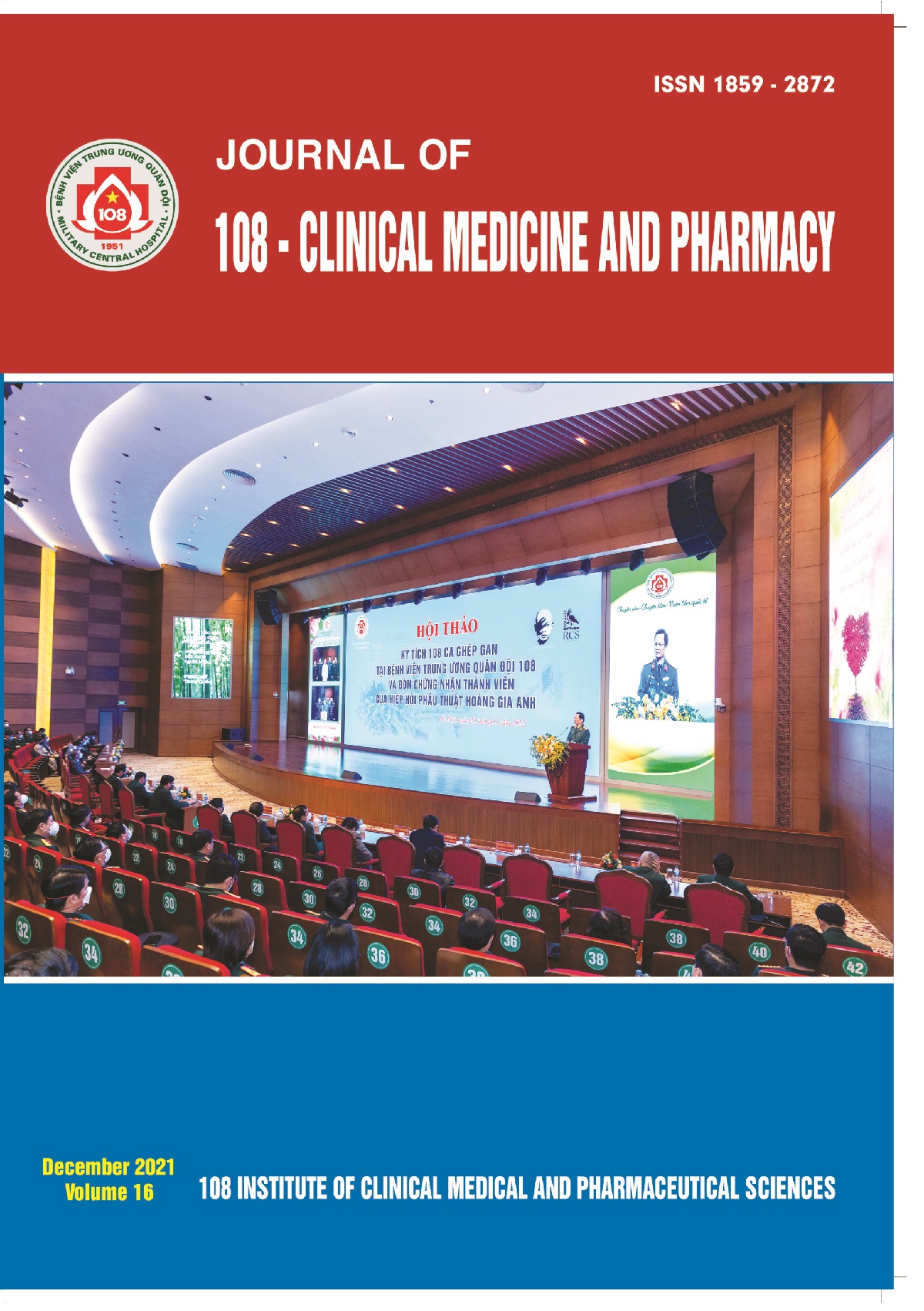SARS-CoV-2 variants circulating in Vietnam, April 2020–October 2021
Main Article Content
Keywords
Tóm tắt
Objective: Several distinct severe acute respiratory syndrome coronavirus 2 (SARS-CoV-2) variants have emerged in different regions worldwide, including Vietnam. This study was conducted is to understand the molecularly genetic epidemiology of SARS-CoV-2 which has not yet been systematically investigated in Vietnamese clinical setting. Subject and method: We analyzed 671 Vietnamese full-length SARS-CoV-2 sequences available on the Global Initiative on Sharing All Influenza Data (GISAID) with data available by 19 October 2021. Sequence variation was done using CoVsurver mutations App (https://www.gisaid.org/epiflu-applications/covsurver-mutations-app/). Phylogenetic tree was built using nextclade algorithms. Result: Our report highlighted that there has been a substantial change in the molecular epidemiology of SARS-CoV-2 circulating through last three waves and ongoing wave of COVID-19. Currently, the Delta variant was dominant with widespread national level. The Alpha variant was almost disappeared and other VOCs, including Beta, Gamma were speculated to be not circulating yet in Vietnam. Conclusion: Surveillance of the emergent variants of SARS-CoV-2 requires an expanded research program to improve our understanding of emerging SARS-CoV-2 mutations profile and their impact on the protective immunity against variants with these mutations. In addition, our surveillance for molecular epidemiology of SARS-CoV-2 in Vietnam will contribute to the efforts at the global levels to fight the pandemic.
Article Details
Các tài liệu tham khảo
2. WHO (2021) Weekly epidemiological update on COVID-19 - 19 October 2021.
3. Katoh K, Misawa K, Kuma K, Miyata T (2002) MAFFT: A novel method for rapid multiple sequence alignment based on fast Fourier transform. Nucleic Acids Res 30(14): 3059-3066. doi: 10.1093/nar/gkf436.
4. Ahmed SB, Dumanski SM (2020) Sex, gender and COVID-19: A call to action. Can J Public Health. 111(6): 980-983. doi: 10.17269/s41997-020-00417-z.
5. Korber B, Fischer WM, Gnanakaran S, Yoon H, Theiler J, Abfalterer W et al (2020) Tracking changes in SARS-CoV-2 spike: Evidence that D614G increases infectivity of the COVID-19 virus. Cell 182(4): 812-827. doi: 10.1016/j.cell.2020 .06.043.
6. Yang TJ, Yu PY, Chang YC, Hsu SD (2021) D614G mutation in the SARS-CoV-2 spike protein enhances viral fitness by desensitizing it to temperature-dependent denaturation. J Biol Chem: 101238. doi: 10.1016/j.jbc.2021.101238.
7. Zhang L, Jackson CB, Mou H, Ojha A, Peng H, Quinlan BD et al (2020) SARS-CoV-2 spike-protein D614G mutation increases virion spike density and infectivity. Nat Commun 11(1): 6013. doi: 10.1038/s41467-020-19808-4.
8. Binquan Luan HW, Tien Huynh (2021) Molecular mechanism of the N501Y Mutation for enhanced binding between SARS-CoV-2’s spike protein and human ACE2 receptor. BioRxiv. doi: 10.1101/2021.01.04.425316.
9. Daniloski Z, Jordan TX, Ilmain JK, Guo X, Bhabha G, tenOever BR et al (2021) The Spike D614G mutation increases SARS-CoV-2 infection of multiple human cell types. Elife 10. doi: 10.7554/eLife.65365.
10. Lu L, Chu AW, Zhang RR, Chan WM, Ip JD, Tsoi HW et al (2021) The impact of spike N501Y mutation on neutralizing activity and RBD binding of SARS-CoV-2 convalescent serum. EbioMedicine 71: 103544. doi: 10.1016/j.ebiom.2021.103544.
11. Tian F, Tong B, Sun L, Shi S, Zheng B, Wang Z et al (2021) N501Y mutation of spike protein in SARS-CoV-2 strengthens its binding to receptor ACE2. Elife 10. doi: 10.7554/eLife.69091.
12. Liu Y, Liu J, Plante KS, Plante JA, Xie X, Zhang X et al (2021) The N501Y spike substitution enhances SARS-CoV-2 transmission. bioRxiv. 2021. doi: 10.1101/2021.03.08.434499.
13. Liu Y, Liu J, Plante KS, Plante JA, Xie X, Zhang X, Ku Z, An Z, Scharton D, Schindewolf C, Menachery VD, Shi PY, Weaver SC (2021) The N501Y spike substitution enhances SARS-CoV-2 transmission. bioRxiv [Preprint]. 2021 Mar 9:2021.03.08.434499. doi: 10.1101/2021.03.08.434499.
14. McCallum M, De Marco A, Lempp FA, Tortorici MA, Pinto D, Walls AC, Beltramello M, Chen A, Liu Z, Zatta F, Zepeda S, di Iulio J, Bowen JE, Montiel-Ruiz M, Zhou J, Rosen LE, Bianchi S, Guarino B, Fregni CS, Abdelnabi R, Foo SC, Rothlauf PW, Bloyet LM, Benigni F, Cameroni E, Neyts J, Riva A, Snell G, Telenti A, Whelan SPJ, Virgin HW, Corti D, Pizzuto MS, Veesler D (2021) N-terminal domain antigenic mapping reveals a site of vulnerability for SARS-CoV-2. Cell. 184(9):2332-2347.e16. doi: 10.1016/j.cell.2021.03.028.
15. Suryadevara N, Shrihari S, Gilchuk P, VanBlargan LA, Binshtein E, Zost SJ et al (2021) Neutralizing and protective human monoclonal antibodies recognizing the N-terminal domain of the SARS-CoV-2 spike protein. Cell 184(9): 2316-2331. doi: 10.1016/j.cell.2021.03.029.
16. Liu Y, Liu J, Johnson BA, Xia H, Ku Z, Schindewolf C et al (2021) Delta spike P681R mutation enhances SARS-CoV-2 fitness over Alpha variant. bioRxiv.. doi: 10.1101/2021.08.12.456173.
17. Akatsuki Saito TI, Rigel Suzuki, Tadashi Maemura, Hesham Nasser, Keiya Uriu, Yusuke Kosugi, Kotaro Shirakawa, Kenji Sadamasu, Izumi Kimura, Jumpei Ito, Jiaqi Wu, Kiyoko Iwatsuki-Horimoto, Mutsumi Ito, Seiya Yamayoshi, Seiya Ozono, Erika P Butlertanaka, Yuri L Tanaka, Ryo Shimizu, Kenta Shimizu, Kumiko Yoshimatsu, Ryoko Kawabata, Takemasa Sakaguchi, Kenzo Tokunaga, Isao Yoshida, Hiroyuki Asakura, Mami Nagashima, Yasuhiro Kazuma, Ryosuke Nomura, Yoshihito Horisawa, Kazuhisa Yoshimura, Akifumi Takaori-Kondo, Masaki Imai, So Nakagawa, Terumasa Ikeda, Takasuke Fukuhara, Yoshihiro Kawaoka, Kei Sato (2021) SARS-CoV-2 spike P681R mutation, a hallmark of the Delta variant, enhances viral fusogenicity and pathogenicity. bioRxiv 448820; doi: https://doi.org/10.1101/2021.06.17.448820.
18. Kemp SA, Collier DA, Datir RP, Ferreira I, Gayed S, Jahun A et al (2021) SARS-CoV-2 evolution during treatment of chronic infection. Nature 592(7853): 277-282. doi: 10.1038/s41586-021-03291-y.
19. McCallum M, De Marco A, Lempp FA, Tortorici MA, Pinto D, Walls AC et al (2021) N-terminal domain antigenic mapping reveals a site of vulnerability for SARS-CoV-2. Cell 184(9): 2332-2347 e16. doi: 10.1016/j.cell.2021.03.028.
20. Armi M Chaudhari, Dinesh Kumar, Madhvi Joshi, Amrutlal Patel, Chaitanya Joshi (2021) E156G and Arg158, Phe-157/del mutation in NTD of spike protein in B.1.617.2 lineage of SARS-CoV-2 leads to immune evasion through antibody escape. BioRxiv. 2021. doi: https://doi.org/10.1101/2021.06.07.447321.
 ISSN: 1859 - 2872
ISSN: 1859 - 2872
